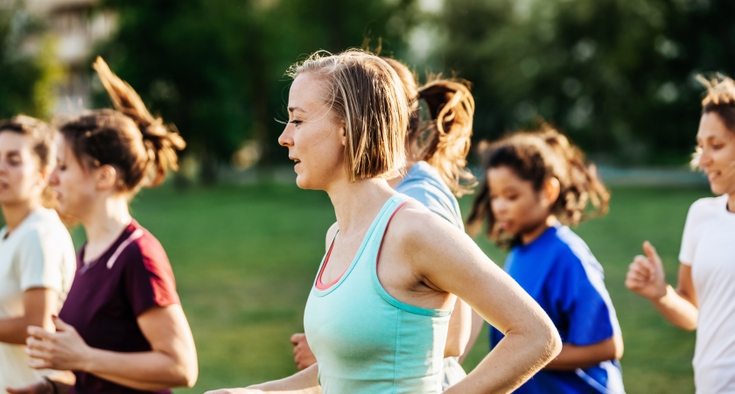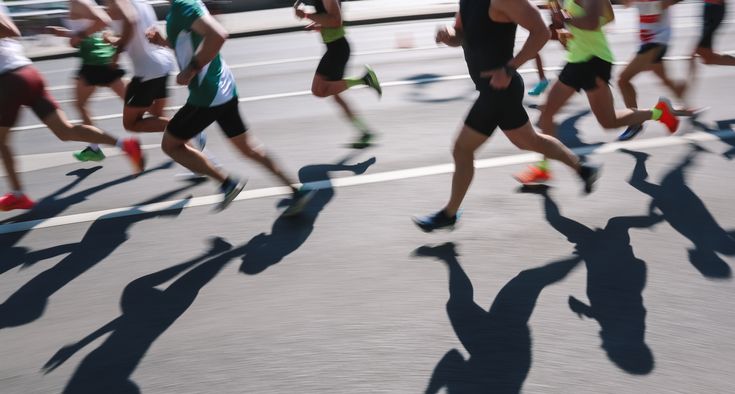Long-distance running isn’t for everybody. But daily physical activity is a must at any age, and one of the most important things you can do for your health.
Whatever aerobic activity you choose, at least a half-hour of moderate-intensity exercise, five days a week, is the goal, the U.S. Department of Health and Human Services advises. Brisk walking, climbing stairs, dancing, swimming, roller skating, jogging and riding a bike all count. But don’t overdo it and try to do a whole week’s worth of activity all at once, especially if you’re just starting to add exercise to your routine.

“It can be tempting for the person just starting out to want to get ahead of the curve, but your body is your best barometer for how much to train,” said family medicine physician Dr. Dominick DeFelice, a faculty member of the Novant Health New Hanover Regional Medical Center family medicine residency program in Wilmington.
DeFelice, 32, is a sports medicine doctor and will be among the health care professionals treating runners on-site during the Novant Health Wilmington Marathon on Feb. 22.
To optimize your fitness and achieve the endurance of a marathon runner, DeFelice advises pacing yourself by following these tips.
Starting a new sport or activity? Get a checkup first to ensure your best performance.
5 health tips to build the endurance of a marathon runner
1. Push yourself, but not to exhaustion.
The warning signs are obvious: Shortness of breath or severe joint pain while working out are red flags that you’re overdoing it.
“Too much exercise can be hard on the joints and aggravate a past injury,” DeFelice said.
Overtraining can complicate your musculoskeletal and cardiovascular health, and show up in the form of muscle cramps like charley horses, and tightness in the hamstrings and hip flexors.
Insufficient training is just as harmful as overdoing it, and can risk injuring bones, tendons and muscles. These take the brunt of force during a run.
“There is a certain percentage of people doing half-marathons and marathons who haven’t taken the optimal training regimen prior to race day,” DeFelice said. “If someone goes from couch to half-marathon in a short period of time, they run the risk of injuries.”
Plantar fasciitis is the most common source of heel pain, and Achilles tendinitis is a common overuse injury. A twisted ankle or muscle cramp can cause prolonged soreness and fatigue that can throw off your activity for weeks.
Doing too much too fast can lead to setbacks in your training and performance, so it’s best to start slowly and gradually build toward your goals.
2. Hydrate, hydrate, hydrate.
Whether you’re a marathon runner or a casual walker, drinking enough water is an absolute must when you’re sweating.
While dehydration is often associated with hot weather, it can occur at any time of year, even during the Wilmington Marathon’s typically chilly February temps. Because several layers of clothing wick up moisture, this can make it less noticeable when you are sweating.
Why is dehydration so dangerous? Because when your fluid levels are too low, your heart must work harder to pump blood throughout your body. Warning signs to look out for are dark urine, dizziness, headache, fast heart rate and confusion.
For marathon runners, DeFelice advises against attempting to cut weight by sprinting while wearing garbage bags, a dangerous activity that can require IV fluids on race day.
“You need to be really well-hydrated with water and electrolytes,” DeFelice said. “Sodium, potassium and calcium are critical to muscle function and avoiding cramps, while electrolytes get blood flowing to the brain.”
A general guideline for adults is to drink 4-8 ounces of water every 20 minutes while exercising. Research shows that drinking small amounts of water at shorter intervals is more effective than drinking large amounts less frequently.
Best doctors. Amazing nurses. Remarkable care.
3. Talk to a nutritionist.
Just as critical as hydration is the right diet, which can make or break your health goals. Physical activity requires fuel, which is why DeFelice advises talking to a registered dietitian to look at your long-term fitness plan.
“The days leading up to and after an endurance event are critical,” DeFelice said. “Someone training for a half-marathon or marathon might require 3,000 calories a day, because they need more nutrients for muscle-building and more calcium and phosphorus for bone health.”
Failing to replenish calories can lead to inadequate nutrition and poor health consequences. Relative energy deficiency in sport syndrome (RED-S) disproportionately affects young female athletes who burn more calories than they consume.
When you’re upping your physical activity, be sure to avoid intermittent fasting, DeFelice said. Eating regular, well-balanced meals that contain carbohydrates, proteins and healthy fats is important to prevent fatigue, replenish glycogen (energy) stores and repair muscles.
4. Dress for success, and don’t forget the sunscreen.
A comfortable pair of shoes is worth the long-term investment for your body and overall health, DeFelice said, particularly for runners.
“Quality shoes will pay for themselves multiple times over in terms of the health of your feet, knees, hips and back,” he said.
Just as important for your overall health? Sunscreen.
“Three to six hours of running a marathon is as much of a risk to your skin as spending that same amount of time on the beach,” DeFelice says. “If you’re not going to wear long sleeves or pants, you must wear sunscreen.”
That goes for people of every age and skin tone, and in every type of weather, including frigid winter days.
5. Don’t assume it’s too late to start a new exercise routine.
It can be intimidating to get moving again if it’s been a while. But don’t let your age or health status hold you back. There’s no age cap when it comes to exercise, DeFelice said.
“It’s more about your baseline health and any cardiovascular or musculoskeletal concerns prior to training,” he said.
In general, he said, if a heart issue like congestive heart failure or atrial fibrillation (A-fib) is well-controlled, you should be good to go the distance. Checking with your primary care physician is always a good idea before you begin a new exercise routine.
So get out there and get moving, and make sure to listen to your body.













